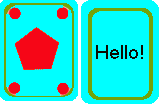OLPCities/Mouse over and click: Difference between revisions
No edit summary |
No edit summary |
||
| (10 intermediate revisions by 2 users not shown) | |||
| Line 1: | Line 1: | ||
There are two very usual resources that are used when we are working using Sprites: the "mouse-over" and the "mouse-click". |
There are two very usual resources that are used when we are working using Sprites: the "mouse-over" and the "mouse-click". |
||
The Class [[Sprites]] has four properties that we use: |
The Class [[OLPCities/Sprites|Sprites]] has four properties that we use: |
||
<pre> |
<pre> |
||
| Line 17: | Line 17: | ||
</pre> |
</pre> |
||
<b>IMPORTANT: To use any of the last four properties you need to create an object of the Class [[Mouse]] </b> |
<b>IMPORTANT: To use any of the last four properties you need to create an object of the Class [[OLPCities/Mouse|Mouse]] </b> |
||
[[Image:Hello.gif |left]] |
[[Image:Hello.gif |left]] |
||
<br clear=all> |
|||
Our exercice will be very easy. We will use "mouse=over" and "mouse-out" to change the face of a card. |
Our exercice will be very easy. We will use "mouse=over" and "mouse-out" to change the face of a card. |
||
Educational games using pairs of cards are very usual. |
Educational games using pairs of cards are very usual. |
||
To have a so big card over the floor of a Lot is not very real but nothing at the OLPCities is very real :-) |
To have a so big card over the floor of a Lot is not very real but nothing at the OLPCities is very real :-) |
||
<p>Look the complete code of the exercice: |
<p>Look the complete code of the exercice: |
||
| Line 45: | Line 37: | ||
<script language="Javascript" src="http://www.dmu.com/olpc/gamelib_mouse.js"></script> |
<script language="Javascript" src="http://www.dmu.com/olpc/gamelib_mouse.js"></script> |
||
<script language="Javascript"> |
<script language="Javascript"> |
||
Gl_preloader(" |
Gl_preloader("avat1.gif"); |
||
Gl_preloader("floorW02G0.gif"); |
Gl_preloader("floorW02G0.gif"); |
||
Gl_preloader("hello.gif"); |
Gl_preloader("hello.gif"); |
||
| Line 56: | Line 47: | ||
mymouse=Ms_initmouse(); //You need this to use mouse-over and click |
mymouse=Ms_initmouse(); //You need this to use mouse-over and click |
||
avataresc = new Gl_cookie("avatesc"); |
|||
if(avataresc.value == null)avataresc.setvalue("http://www.dmu.com/olpcavatar/avat1.gif"); |
|||
entryt = new Gl_cookie("entt"); |
entryt = new Gl_cookie("entt"); |
||
upkey=Kb_trapkey("UP"); |
upkey=Kb_trapkey("UP"); |
||
downkey=Kb_trapkey("DOWN"); |
downkey=Kb_trapkey("DOWN"); |
||
| Line 67: | Line 55: | ||
av=new Sp_Sprite(); |
av=new Sp_Sprite(); |
||
av.setImage( |
av.setImage(("avat1.gif" ,32,32,4,2); |
||
av.setXlimits(100,610); |
av.setXlimits(100,610); |
||
av.setYlimits(80,280); |
av.setYlimits(80,280); |
||
| Line 117: | Line 105: | ||
hello.switchOn(); |
hello.switchOn(); |
||
Gl_hook("timestep()"); |
Gl_hook("timestep()"); |
||
Gl_start(); |
Gl_start(); |
||
} |
} |
||
| ⚫ | |||
function timestep(){ |
function timestep(){ |
||
| Line 147: | Line 133: | ||
} |
} |
||
}//timestep |
}//timestep |
||
| Line 159: | Line 143: | ||
</html> |
</html> |
||
</pre> |
</pre> |
||
Look and move the mouse over the card and finally click it - it will disapear. It's not a game, only an exercice.: |
|||
[http://www.dmu.com/olpctut/tut8.html http://www.dmu.com/olpctut/tut8.html]. |
|||
<b>OBS: An sprite can also be draggable. This is very useful for the creation of educational games Details at the reference of the Class [[OLPCities/Sprites|Sprites]]</b>. |
|||
| ⚫ | |||
<center>PREVIOUS LESSON: [[OLPCities/Inside a house|Inside a house ]]...........TOC :[[OLPCities/Tutorials|Tutorials]]..........NEXT LESSON : [[OLPCities/Dynamic write|Dynamic write]]</center> |
|||
[[Category:OLPCities Tutorials]] |
|||
Latest revision as of 03:45, 14 February 2007
There are two very usual resources that are used when we are working using Sprites: the "mouse-over" and the "mouse-click".
The Class Sprites has four properties that we use:
onmouseover [=String] The string is the function name to be called when the mouse
pointer has moved over the sprite. This CAN include arguments so
mySprite.onmouseover="dosomething(x,y,z)" would pass the variables x,y,z
to the function dosomething
onmouseout [=String} The string is the function name to be called
onclickdown [=String] The string is the function name to be called
onclickup [=String] The string is the function name to be called
IMPORTANT: To use any of the last four properties you need to create an object of the Class Mouse
Our exercice will be very easy. We will use "mouse=over" and "mouse-out" to change the face of a card.
Educational games using pairs of cards are very usual.
To have a so big card over the floor of a Lot is not very real but nothing at the OLPCities is very real :-)
Look the complete code of the exercice:
<html>
<head>
<script language="Javascript" src="http://www.dmu.com/olpc/gamelib_core.js"></script>
<script language="Javascript" src="http://www.dmu.com/olpc/gamelib_sprites.js"></script>
<script language="Javascript" src="http://www.dmu.com/olpc/gamelib_keyboard.js"></script>
<script language="Javascript" src="http://www.dmu.com/olpc/gamelib_mouse.js"></script>
<script language="Javascript">
Gl_preloader("avat1.gif");
Gl_preloader("floorW02G0.gif");
Gl_preloader("hello.gif");
function init(){
Sp_linuxcompatible=true;
mymouse=Ms_initmouse(); //You need this to use mouse-over and click
entryt = new Gl_cookie("entt");
upkey=Kb_trapkey("UP");
downkey=Kb_trapkey("DOWN");
rightkey=Kb_trapkey("RIGHT");
leftkey=Kb_trapkey("LEFT");
av=new Sp_Sprite();
av.setImage(("avat1.gif" ,32,32,4,2);
av.setXlimits(100,610);
av.setYlimits(80,280);
if(entryt.value=="E"){
av.moveTo( 550,150);
av.setFrame(0);
entryt.setvalue("G");
}
else if(entryt.value=="W"){
av.moveTo(125,150);
av.setFrame(1);
entryt.setvalue("G");
}
else{ //can be null
av.moveTo( 255,235);
av.setFrame(3);
entryt.setvalue("G");
}
av.setFrameByDirection(90,90,1,180,180,3,270,270,0,0,0,2);
av.setAnimation(0);
av.setZ(10);
av.collides=true;
av.useHitEvents(true);
av.setAnimationSpeed(3);
av.switchOn();
floor=new Sp_Sprite();
floor.setImage("floorW02G0.gif",614,390,1,1);
floor.setXlimits( 0,614);
floor.setYlimits( 0,390);
floor.setFrame(0);
floor.moveTo(0 , 0 );
floor.setZ(5);
floor.switchOn();
hello=new Sp_Sprite();
hello.setImage("hello.gif",80,105,2,1);
hello.setXlimits( 0,614);
hello.setYlimits( 0,390);
hello.setFrame(0);
hello.makeHard();
hello.moveTo(160 , 50 );
hello.setZ(12);
hello.onmouseover="hello.setFrame(1)";
hello.onmouseout="hello.setFrame(0)";
hello.onclickup="hello.switchOff();";
hello.switchOn();
Gl_hook("timestep()");
Gl_start();
}
function timestep(){
av.setSpeed(0);
av.setAnimationRepeat(0);
if(rightkey.pressed){
av.setDir(1,0);
av.setAnimationRepeat(-1);
av.setSpeed(2);
}
else if(leftkey.pressed){
av.setDir(-1,0);
av.setAnimationRepeat(-1);
av.setSpeed(2);
}
else if(downkey.pressed){
av.setDir(0,1);
av.setAnimationRepeat(-1);
av.setSpeed(2);
}
else if(upkey.pressed){
av.setDir(0,-1);
av.setAnimationRepeat(-1);
av.setSpeed(2);
}
}//timestep
</script>
</head>
<title>TUTCITY </title>
<body bgcolor="black" onload="init()" >
</html>
Look and move the mouse over the card and finally click it - it will disapear. It's not a game, only an exercice.: http://www.dmu.com/olpctut/tut8.html.
OBS: An sprite can also be draggable. This is very useful for the creation of educational games Details at the reference of the Class Sprites.
